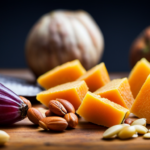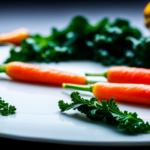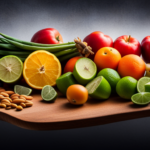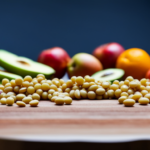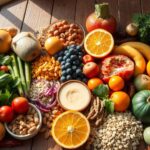Getting Started with Raw Food
What Classifies As Raw Food
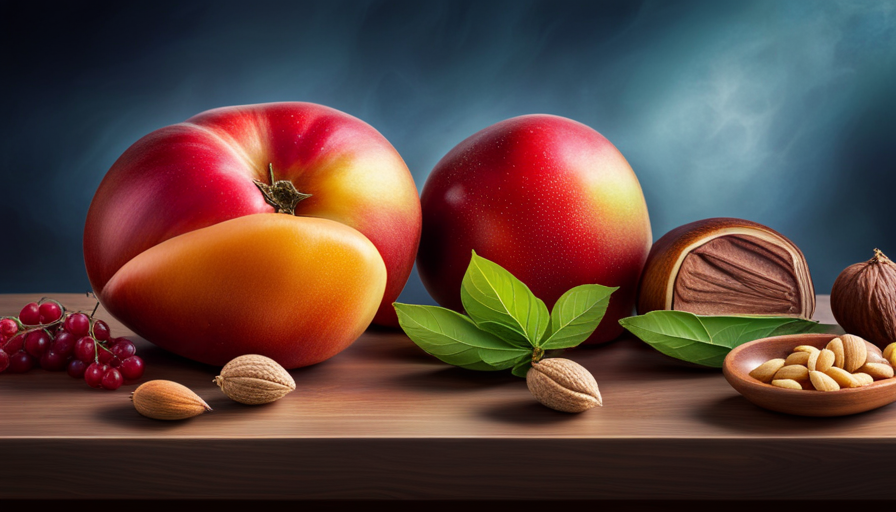
Have you ever taken a bite of a crunchy, juicy apple and experienced a burst of flavors swirling on your taste buds? That delightful moment is what raw food enthusiasts such as myself aim to enjoy with each meal. I am a strong advocate of nature’s gifts and have fully embraced the raw food way of life, which promotes the consumption of unprocessed, raw, and organic foods.
But what exactly classifies as raw food? In this article, we will explore the various categories of raw foods, including fruits and vegetables, nuts and seeds, grains, and even dairy products. We will delve into the preparation techniques that preserve the nutritional integrity of these foods, as well as discuss the safety measures to follow when consuming raw food.
Whether you’re curious about transitioning to a raw food diet or simply interested in understanding the principles behind it, this article will provide you with an informative and evidence-based exploration of the raw food lifestyle.
So, let’s embark on this journey together and discover the wonders of raw food!
Key Takeaways
- Raw food refers to unprocessed, uncooked, and organic foods consumed in their natural state.
- Raw food is not cooked, processed, or heated above 118 degrees Fahrenheit (48 degrees Celsius).
- Raw food is rich in essential nutrients, vitamins, minerals, and enzymes.
- Raw food diets may aid in weight management and promote digestive health.
Definition of Raw Food
So, what exactly qualifies as raw food? Raw food refers to any food that is consumed in its natural state, without undergoing any form of cooking, processing, or heating above 118 degrees Fahrenheit (48 degrees Celsius). This includes fruits, vegetables, nuts, seeds, and certain dairy products like raw milk and cheese.
Raw food enthusiasts argue that consuming raw food provides numerous benefits. Firstly, raw food is rich in essential nutrients, such as vitamins, minerals, and enzymes, which can be destroyed or reduced during cooking. Additionally, raw food is often lower in calories and higher in fiber, which can aid in weight management and promote digestive health. Some studies suggest that raw food diets may also lower the risk of chronic diseases like heart disease and certain cancers.
However, it is important to note that there are potential risks associated with consuming raw food. Raw food may contain harmful bacteria and parasites, which can cause foodborne illnesses. It’s crucial to handle and prepare raw food properly to minimize these risks.
Moving on to fruits and vegetables, these are key components of a raw food diet. They’re packed with vitamins, minerals, antioxidants, and phytochemicals that are beneficial for overall health.
Fruits and Vegetables
Crisp and vibrant, fruits and vegetables burst with natural goodness. They’re not only delicious, but also packed with essential vitamins, minerals, and fiber. Incorporating more raw fruits and vegetables into your diet can have numerous benefits for your health.
Here are five reasons why you should consider adding more of them to your daily meals:
-
Nutrient-rich: Raw fruits and vegetables are a great source of vitamins and minerals that are essential for overall well-being. They provide antioxidants that help protect your body against harmful free radicals.
-
Digestive health: The high fiber content in raw fruits and vegetables promotes healthy digestion and prevents constipation. They also contain enzymes that aid in the digestion process.
-
Weight management: Raw fruits and vegetables are low in calories and high in water content, making them a perfect option for weight management. They provide a feeling of fullness, reducing the chances of overeating.
-
Immune system support: Eating raw fruits and vegetables can strengthen your immune system due to their high content of vitamin C and other immune-boosting nutrients.
-
Heart health: Studies have shown that a diet rich in raw fruits and vegetables can lower the risk of heart disease by reducing blood pressure and cholesterol levels.
To incorporate more raw fruits and vegetables into your diet, try starting your day with a fruit smoothie or adding a side salad to your meals. Remember to wash them thoroughly and eat them fresh to maximize their nutritional benefits.
As we move on to the next section about nuts and seeds, you’ll discover their amazing health benefits as well.
Nuts and Seeds
Packed with essential nutrients, nuts and seeds are a delicious and convenient way to boost your overall health. These small powerhouses aren’t just rich in healthy fats, fiber, and protein, but they also provide a wide range of vitamins, minerals, and antioxidants.
From almonds and walnuts to chia seeds and flaxseeds, each type of nut and seed offers its own unique nutritional benefits.
Nuts and seeds are known for their heart-healthy properties. Studies have shown that incorporating them into your diet can help lower cholesterol levels and reduce the risk of heart disease. Additionally, they’re a great source of plant-based protein, making them an excellent choice for vegetarians and vegans.
In the culinary world, nuts and seeds have endless possibilities. They can be enjoyed on their own as a quick and nutritious snack, or added to salads, smoothies, and baked goods for an extra crunch. You can even make your own homemade nut butter or seed-based dressing for a flavorful twist.
As we move on to the next section about grains, it’s important to note that incorporating a variety of nuts, seeds, fruits, and vegetables into your diet is key to maintaining a balanced and nutritious eating plan.
Grains
Grains are an essential part of a healthy diet, providing a versatile and delicious foundation for countless meals and snacks. They’re a great source of carbohydrates, fiber, and essential nutrients like B vitamins and minerals.
When it comes to raw food, there’s some debate about whether grains can be considered raw. While most grains are typically cooked before consumption, there’s an alternative method called sprouting that allows grains to be eaten in their raw form. Sprouting involves soaking the grains in water until they begin to germinate. This process activates enzymes and increases the nutrient content of the grains.
Sprouted grains are easier to digest and may have higher levels of certain vitamins and minerals compared to their cooked counterparts. They can be used in various dishes like salads, raw bread, and raw granola. Incorporating sprouted grains into a raw food diet adds variety and texture to meals. However, it’s important to note that not all grains are suitable for sprouting. Some grains, like wheat, are more commonly sprouted, while others, like rice, are typically cooked. It’s always best to research and follow proper sprouting techniques to ensure food safety.
Moving on to the next section about dairy products, it’s important to understand the role they play in a raw food diet.
Dairy Products
When it comes to dairy products, two key points that I’d like to discuss are raw milk and its benefits, as well as the options for raw cheese and yogurt.
Raw milk is milk that hasn’t been pasteurized or homogenized, and it’s believed to retain more nutrients and enzymes compared to processed milk.
Raw cheese and yogurt are made from raw milk and can offer a range of flavors and textures that are different from their pasteurized counterparts.
These options provide an opportunity to explore different tastes and potential health benefits.
Raw Milk and Its Benefits
If you’re looking to enhance your diet with a natural and nutrient-rich beverage, consider giving raw milk a try. Raw milk is milk that hasn’t been pasteurized or homogenized, meaning it’s in its natural state.
Many people choose raw milk as an alternative to conventional milk because they believe it contains more beneficial nutrients and enzymes. However, it’s important to note that raw milk also comes with some controversy. Critics argue that raw milk can contain harmful bacteria that can cause foodborne illnesses.
Despite this controversy, some studies suggest that raw milk may have certain health benefits, such as a higher content of vitamins and minerals.
If you’re interested in exploring raw milk options, it’s also worth considering raw cheese and yogurt, which are made from raw milk and offer their own unique benefits.
Raw Cheese and Yogurt Options
Consider trying out different varieties of raw cheese and yogurt made from unpasteurized milk, as they offer a unique and flavorful addition to your diet.
Raw cheese, like raw milk, contains beneficial bacteria and enzymes that can aid in digestion and improve gut health. It’s also rich in vitamins and minerals such as calcium, phosphorus, and vitamin A. Additionally, raw cheese is often made using traditional methods, preserving the natural flavors and textures of the milk.
As for yogurt, making your own homemade yogurt from raw milk allows you to control the ingredients and fermentation process, ensuring a high-quality product. Homemade yogurt can be a great source of probiotics, protein, and calcium.
These raw cheese and yogurt options provide a nutritious and delicious alternative to their pasteurized counterparts.
Moving on to the next section, let’s explore the benefits of raw food diets.
Raw Food Diets
Indulge in the vibrant world of raw food diets, where your plate becomes a canvas of crisp greens, juicy fruits, and nourishing nuts and seeds. Raw food diets have gained popularity in recent years due to their numerous health benefits. By consuming uncooked, unprocessed foods, you can maximize the nutritional value of your meals.
Raw foods are rich in enzymes, vitamins, minerals, and antioxidants, which can support digestion, boost immunity, and improve overall well-being. One of the advantages of a raw food diet is the abundance of raw food recipes available. From refreshing salads and smoothies to inventive raw desserts, there are endless possibilities to explore. You can experiment with different combinations of fruits, vegetables, and nuts to create delicious and nourishing meals that’ll satisfy your taste buds and provide your body with essential nutrients.
Transitioning into the next section about raw food preparation techniques, it’s important to understand that raw food diets require specific methods to ensure food safety and enhance flavor. By utilizing techniques such as soaking, sprouting, and dehydrating, you can unlock the full potential of raw ingredients, making them easier to digest and enhancing their natural flavors.
So, let’s dive into the world of raw food preparation techniques and discover how to unleash the true essence of these vibrant and nutritious foods.
Raw Food Preparation Techniques
Let’s dive into the exciting world of preparing raw ingredients and discover how to unlock their full potential for maximum flavor and nutrition.
When it comes to raw food preparation techniques, there are countless options to explore. One of the key benefits of raw food is that it retains its natural enzymes and nutrients, which can be lost through cooking. By using techniques like soaking, sprouting, and fermenting, we can enhance the nutritional value of raw ingredients even further.
Soaking is a simple yet effective technique that involves immersing ingredients like nuts, seeds, and grains in water for a certain period of time. This process not only softens the texture but also helps to remove any anti-nutrients, making the ingredients more digestible and increasing their nutrient availability.
Sprouting, on the other hand, involves germinating seeds and legumes to increase their nutrient content and improve digestibility.
When it comes to raw food recipes, the possibilities are endless. From refreshing salads and smoothies to delicious raw desserts, there is something for everyone. Raw food recipes often showcase the natural flavors and textures of ingredients, allowing them to shine in their purest form.
As we delve into the world of raw food safety, it’s important to ensure that we handle raw ingredients properly to prevent foodborne illnesses.
Raw Food Safety
Ensuring the safety of our culinary creations is of utmost importance, as we navigate the realm of uncooked ingredients. When it comes to raw food, nutrition is one of the key factors to consider. Raw foods retain their natural enzymes and nutrients, which can be beneficial for our overall health. However, there are potential risks associated with consuming raw food as well.
To evoke emotion in the audience, let’s delve into two sub-lists:
-
The benefits of raw food:
- Improved digestion: Raw foods are rich in fiber, aiding in digestion and promoting a healthy gut.
- Enhanced nutrient absorption: Raw foods are packed with essential vitamins and minerals that are easily absorbed by our bodies.
-
The potential risks of raw food:
- Bacterial contamination: Raw foods may contain harmful bacteria like Salmonella or E. coli, which can cause foodborne illnesses.
- Nutrient deficiencies: While raw foods are nutritious, some nutrients are better absorbed when cooked, such as lycopene in tomatoes.
Transitioning to a raw food diet requires careful consideration of these potential risks and benefits. By understanding the importance of food safety and being aware of the potential risks, we can make informed decisions about our culinary journey.
Transitioning to a Raw Food Diet
Embarking on a journey towards a raw food diet can be a transformative experience for our bodies and minds. When transitioning to a raw food diet, it’s important to start slow and gradually increase the amount of raw foods in your meals. This allows your body to adjust and prevents any potential digestive challenges.
Incorporating more fruits, vegetables, nuts, and seeds into your meals is a great way to start. These foods are packed with nutrients and enzymes that are beneficial to our health.
One of the potential challenges of transitioning to a raw food diet is the need for meal planning and preparation. Raw food meals often require more time and effort in the kitchen, as they involve soaking, sprouting, and blending. However, with proper planning and organization, this challenge can be overcome. Preparing meals in advance and having a variety of raw food recipes on hand can make the transition smoother.
Embracing the raw food lifestyle can have numerous benefits for our health. By gradually incorporating more raw foods into our diet and overcoming the potential challenges, we can experience increased energy, improved digestion, and a greater sense of well-being.
So, let’s dive into the world of raw food and discover the amazing benefits it has to offer.
Conclusion: Embracing the Raw Food Lifestyle
Incorporating a raw food lifestyle into my daily routine is like unlocking a vibrant garden of health and vitality, where each bite nourishes my body and rejuvenates my spirit. Not only does this lifestyle provide numerous health benefits, but it also positively impacts my emotional well-being.
One of the key benefits of embracing a raw food lifestyle is the improvement in my emotional well-being. Raw foods are packed with essential nutrients, enzymes, and antioxidants that support brain health and help balance mood. By consuming a diet rich in fruits, vegetables, nuts, and seeds, I experience increased energy levels and mental clarity, which in turn enhances my overall emotional state. I feel more positive, focused, and in control of my emotions.
Moreover, the health benefits of a raw food lifestyle are undeniable. Raw foods are naturally low in calories and high in fiber, which aids in weight management and digestion. Additionally, the abundance of vitamins, minerals, and phytonutrients found in raw foods strengthens my immune system and protects against chronic diseases. I have noticed a significant improvement in my skin health, as well as a reduction in inflammation and joint pain.
Embracing a raw food lifestyle not only improves my physical health but also has a profound impact on my emotional well-being. The nourishing qualities of raw foods provide me with the energy and vitality I need to thrive each day. By choosing to incorporate more raw foods into my diet, I’m taking a proactive step towards a healthier, happier life.
Frequently Asked Questions
Can raw food be cooked at any temperature?
Raw food can be cooked, but it’s important to note that cooking at high temperatures can destroy some of the nutrients and enzymes in the food.
However, there are ways to cook raw food while still preserving its nutritional value. For example, steaming, blanching, or using a dehydrator at low temperatures can help retain nutrients.
Ultimately, the benefits of a raw food diet for overall health and well-being come from consuming foods in their natural state, as they’re rich in vitamins, minerals, and enzymes.
Are frozen fruits and vegetables considered raw?
Frozen fruits and vegetables are not considered raw. While freezing preserves some nutrients, the freezing process alters the texture and can cause a loss in certain vitamins and enzymes. However, they still provide nutritional benefits like vitamins, minerals, and fiber.
It is important to note that consuming raw food, including frozen produce, carries potential safety concerns due to the risk of foodborne illnesses. Proper washing and handling techniques are crucial to minimize these risks.
Can roasted nuts and seeds still be considered raw?
Roasted nuts and seeds cannot be considered raw because they’ve undergone a cooking process. Raw food refers to unprocessed or minimally processed foods that haven’t been heated above a certain temperature. The key difference between raw and processed foods lies in their nutritional content.
Raw nuts and seeds retain their natural enzymes, vitamins, and minerals, which can provide numerous health benefits. These benefits include improved digestion, increased energy, and enhanced nutrient absorption.
Are fermented grains considered raw?
Fermented grains are not considered raw because the fermentation process involves the use of beneficial bacteria or yeast that break down the carbohydrates in the grains. This process enhances the nutritional benefits of the grains by increasing their digestibility and nutrient availability.
To ferment grains at home, you can soak them in water and an acidic medium like lemon juice or apple cider vinegar for a certain period of time. This promotes the growth of beneficial bacteria and initiates the fermentation process.
Is raw milk considered a raw dairy product?
Raw milk is considered a raw dairy product. It has numerous nutritional benefits, as it contains vitamins, minerals, and beneficial enzymes that are destroyed during pasteurization.
Raw milk is also a good source of protein and healthy fats. However, it is important to note that consuming raw dairy products comes with safety concerns. Raw milk can harbor harmful bacteria, such as Salmonella and E. coli, which can cause foodborne illnesses.
Therefore, it’s crucial to handle and store raw milk properly to reduce the risk of contamination.
Is Raw Beef Considered a Type of Raw Food?
Yes, raw beef is considered a type of raw food. When preparing raw beef, it’s important to follow proper food safety guidelines. Some raw beef food naming suggestions include steak tartare, carpaccio, and beef sashimi. Eating raw beef can pose health risks, so it’s important to consume it with caution.
Conclusion
In conclusion, after exploring the world of raw food, I’ve come to appreciate the power of this lifestyle. By embracing the raw food lifestyle, you can experience a range of benefits, from increased energy levels to improved digestion.
However, it’s important to remember that transitioning to a raw food diet requires careful planning and consideration. While the idea of consuming uncooked food may seem daunting, the delicious array of fruits, vegetables, nuts, and seeds available make it a truly tantalizing experience.
So why not give it a try and unlock a new level of health and vitality?
With her ability to convey complex concepts in a clear and accessible manner, Belinda ensures that readers of all backgrounds can grasp the benefits and techniques of raw food. She excels at breaking down scientific information into digestible pieces, allowing readers to understand the impact of raw food on their bodies and encouraging them to make informed choices about their diet.
One of Belinda’s notable contributions to rachaelsrawfood.com is her collection of mouthwatering recipes. She delights in experimenting with various combinations of raw ingredients, exploring innovative ways to create delicious and nutritious meals. Belinda’s recipes showcase the incredible flavors and textures of raw food and emphasize its versatility, dispelling any misconception that a raw food diet is limited or monotonous.
In addition to her writing responsibilities, Belinda actively engages with the raw food community, attending workshops, seminars, and conferences to expand her knowledge and network. She enjoys connecting with like-minded individuals, exchanging ideas, and staying up to date with the latest trends and advancements in the field of raw food nutrition.
Getting Started with Raw Food
Does Raw Food Make Dogs Constipated? Find Out Here
Observe the signs of constipation in dogs on a raw food diet; discover how to ensure their digestive health. What solutions exist?
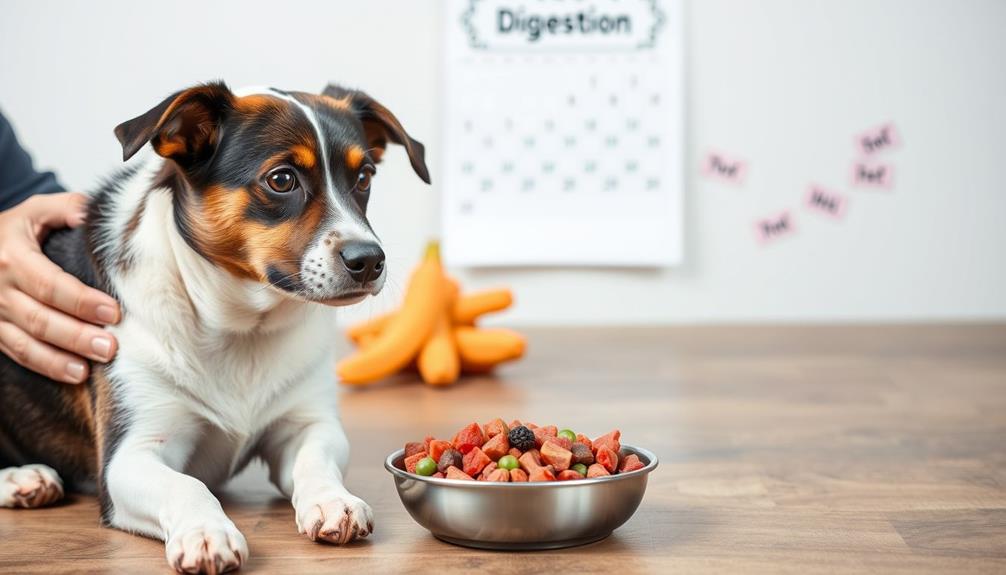
Feeding your dog a raw food diet can indeed cause constipation if it isn't balanced right. Excessive bone content might lead to hard stools, while not including enough fiber from fruits and vegetables can worsen the issue. Dehydration is also common with raw diets, contributing to stool hardness. If you notice signs like straining to defecate or rock-hard stools, it's important to adjust the diet. Adding fiber-rich foods like pumpkin and keeping your dog hydrated are key. There's more you can do to guarantee a healthy digestion for your dog, so keep exploring options for their diet.
Key Takeaways
- Raw diets can lead to constipation due to excessive bone content resulting in hard stools.
- Insufficient fiber from a lack of fruits and vegetables can exacerbate digestive issues.
- Dehydration is common in raw diets, which contributes to stool hardness.
- Rapid transitions to a raw diet without gradual adjustments may disrupt a dog's digestion.
- Regular monitoring of stool consistency and dietary balance is essential for preventing constipation.
Understanding Dog Constipation
Constipation in dogs can be a concerning issue for pet owners, and it's important to recognize the signs early. You might notice that your dog hasn't had a bowel movement for over 24 hours, is straining while trying to defecate, or producing rock-hard stools. These symptoms indicate that your dog's digestive tract needs attention.
Diet plays an essential role in your dog's bowel health, and understanding proper hamster care can help you appreciate the importance of nutrition in pet health. If your dog is on a raw diet, insufficient fiber and excessive bone content can contribute to constipation. It's crucial to provide enough fiber to help your dog maintain regular bowel movements. Foods like pumpkin and leafy greens can be excellent additions to their diet.
Additionally, keep an eye on your dog's hydration and make sure they get plenty of exercise. Both of these factors are significant for promoting healthy digestion and preventing constipation.
If you're concerned about your dog's condition, consider adjusting their diet by reducing bone content and incorporating fiber-rich foods. By taking these steps, you can help your dog overcome constipation and support their overall health.
Causes of Constipation in Raw Diets

A raw diet can sometimes lead to constipation in dogs, primarily due to excessive bone content. When the diet consists of too many bones, it can result in hard stools that hinder regular bowel movements.
Additionally, insufficient fiber intake from a lack of fruits and vegetables can exacerbate the problem. It's essential to incorporate fiber-rich foods like pumpkin and leafy greens to support healthy digestion, as recommended in gout nutrition guidelines.
Dehydration also plays a significant role in constipation. Since raw diets often contain less moisture than processed foods, your dog may not be drinking enough water, further contributing to hard stools.
Stress, changes in routine, or dietary imbalances can influence gut motility, leading to irregular bowel movements as well.
Moreover, if you shift your pet to a raw diet too quickly without a gradual introduction of new foods, it can disrupt their digestive system. This sudden change may result in constipation or other gastrointestinal issues.
To prevent these causes of constipation, verify that your dog's raw diet is balanced and includes sufficient fiber and hydration. This way, you can help maintain your dog's digestive health.
Signs and Symptoms to Observe

Recognizing the signs and symptoms of constipation in your dog is essential for timely intervention. Pay close attention to any lack of stool for over 24 hours, as this can be a clear indication that your dog is experiencing constipation.
If you notice your dog is straining during defecation, it's vital to take action. Straining often accompanies hard stools that resemble pebbles, signaling that your dog may be in discomfort. Additionally, providing your dog with healthy snacks can promote better digestion and overall health, potentially mitigating constipation issues.
Behavioral changes can also be significant. If your dog seems reluctant to move, avoids activities they usually enjoy, or shows signs of discomfort while attempting to relieve themselves, these may be warning signs of constipation.
It's important to monitor stool consistency regularly. Hard stools can lead to further complications, so keeping an eye on your dog's bathroom habits is key.
Dietary Adjustments for Relief
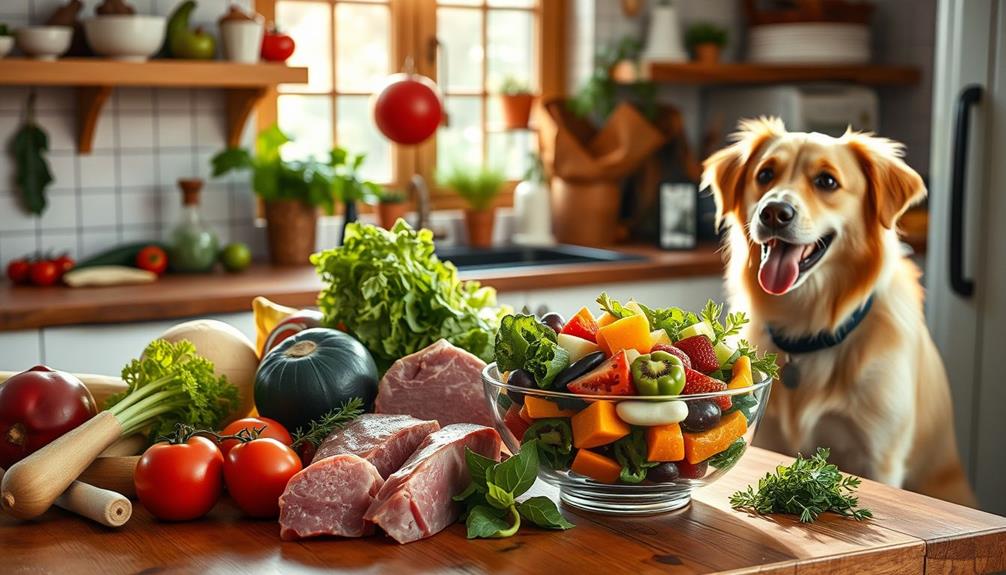
Making dietary adjustments can greatly help alleviate your dog's constipation. Start by reducing the frequency of raw meaty bones in their diet, as these can lead to drier, harder stools.
Instead, focus on incorporating extra fruits and vegetables, like pumpkin or leafy greens, which provide essential fiber that aids in regulating bowel movements. Additionally, guaranteeing proper hydration is vital; consider how air quality considerations can parallel maintaining your dog's overall health, including digestive wellness.
Feeding a balanced raw diet consisting of 80% muscle meat, 10% bone, and 10% offal guarantees your dog gets adequate moisture and nutrients, promoting healthy digestion.
Pureed pumpkin or canned unsweetened pumpkin can be particularly effective, thanks to its high fiber content, making it easier for your dog to defecate without straining.
Don't forget about hydration! Make sure your dog has access to fresh water or bone broth, as regular hydration is essential for maintaining stool consistency and preventing constipation.
By making these dietary adjustments, you'll create a more balanced raw food experience that supports your dog's digestive health and helps alleviate constipation.
Supplement Options for Digestive Health
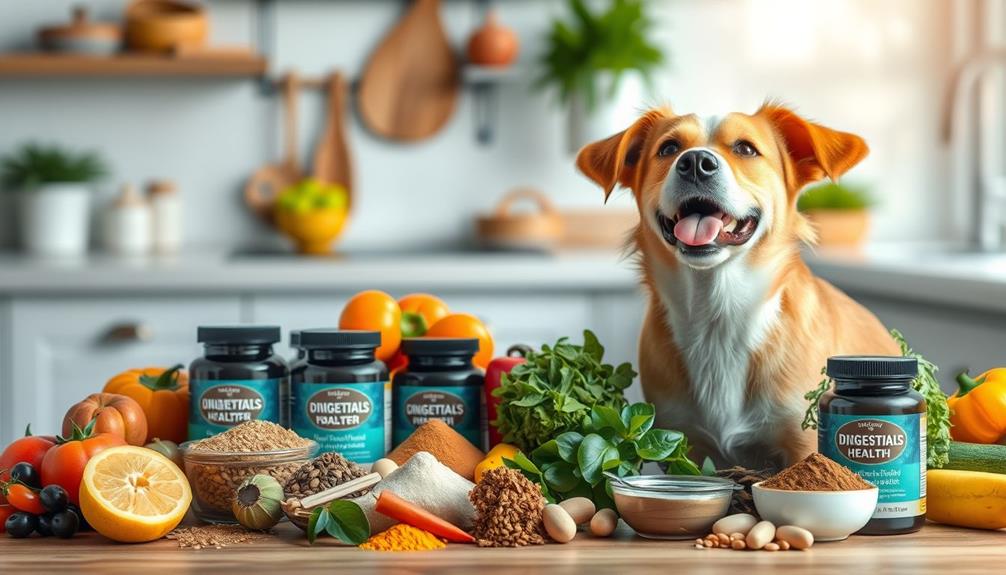
How can you enhance your dog's digestive health while minimizing constipation? Exploring effective supplement options can make a significant difference. Here are some to evaluate:
- Probiotics: These promote a diverse gut microbiome, which is essential for good digestion and can help mitigate issues such as gastrointestinal issues.
- Digestive enzymes: They help break down raw proteins and fats, improving nutrient absorption.
- Slippery elm: This natural remedy soothes the gastrointestinal tract and creates a protective mucous lining. A dosage of ¼ teaspoon per 10 lbs of body weight is recommended.
- Leafy greens: Incorporating fiber-rich foods like kale or spinach can regulate bowel movements, alleviating constipation.
- Omega-3 oil: Regular supplementation with this healthy oil supports overall digestive health and improves stool consistency.
When to Consult a Veterinarian

If your dog hasn't had a bowel movement in over 24 hours, it's time to consult a veterinarian.
It's important to keep an eye on your dog's overall behavior and health, as changes can indicate underlying issues that may require immediate attention.
Look out for persistent straining, discomfort, or any behavioral changes that indicate pain.
Addressing these signs early can help prevent more serious health issues down the line.
Additionally, emotional and psychological support available for families can be beneficial during such stressful times.
Persistent Lack of Stool
When your dog goes more than 24 hours without a stool, it's time to consult a veterinarian to rule out any serious health issues. A persistent lack of stool can indicate underlying problems that need addressing.
Here are some signs to watch for:
- Decreased energy levels or reluctance to move
- Hard, rock-like stools that signal constipation
- Straining to defecate with little or no output
- Signs of pain during attempts to relieve themselves
- Changes in appetite or behavior, indicating discomfort
If your dog's raw food diet lacks fiber, it could cause constipation, leading to infrequent dogs' bowel movements. Adding vegetables such as spinach, carrots, and sweet potatoes to their diet can help increase the fiber content and improve their digestion. It is important to consult with a veterinarian before switching to raw dog food, as they can provide guidance on the best diet for your dog’s specific needs. In some cases, adding a fiber supplement may also be necessary to ensure your dog’s digestive health.
Creating a personal budget for your pet's dietary needs can guarantee they receive the right nutrients. Loose stools can also disrupt gut health, making it essential to maintain a balanced diet.
If you notice any of these symptoms, don't hesitate to seek veterinary advice. Early intervention is key to identifying and treating the root cause of your dog's persistent lack of stool.
Delaying could complicate the situation, so it's best to act promptly. Remember, your dog's well-being depends on your vigilance in recognizing these signs!
Straining and Discomfort Signs
Straining to defecate can be a clear sign that your dog is experiencing constipation, and it's important to recognize this symptom early.Breast cancer symptoms in dogs can sometimes mimic signs of discomfort, so it's vital to differentiate between the two. If you notice your dog straining excessively or having difficulty passing stool, it's necessary to consult a veterinarian, especially if this persists. Signs of discomfort, like whining or trembling while attempting to defecate, should prompt an immediate visit to the vet.
A lack of bowel movements for more than 24 hours is a significant indicator of constipation and requires professional evaluation to rule out any underlying issues. Additionally, if your dog produces rock-hard stool consistently, this often signifies constipation, and you should seek veterinary advice.
Keep an eye on any changes in your dog's behavior; decreased activity levels or reluctance to move may also signal discomfort related to being constipated.
Addressing these signs of discomfort promptly can help prevent more serious health problems down the line. Remember, when in doubt about your dog's bowel habits or overall well-being, don't hesitate to reach out for a veterinary consultation. Your dog's health and comfort should always come first.
Behavioral Changes and Pain
Recognizing behavioral changes in your dog can provide important clues about their health, especially regarding constipation.
Similar to individuals with BPD dynamics in relationships, dogs may exhibit changes in behavior when experiencing discomfort or pain. If your dog exhibits any of the following signs, it's time to reflect on a vet consultation:
- Reluctance to move or play
- Straining and difficulty when trying to defecate
- Whining or trembling during attempts to have a bowel movement
- Rock-hard stools that are difficult to pass
- An absence of bowel movements for more than 24 hours
These signs of pain and discomfort can indicate that your dog needs immediate attention.
Straining to defecate is a clear indicator of constipation, and if your pet struggles for over a day, it may suggest a more serious underlying issue. Obvious signs of distress during defecation, such as whining, should never be ignored.
If you notice any of these behavioral changes, don't hesitate to consult your vet.
Early intervention can prevent complications and guarantee your dog's digestive health is maintained.
Frequently Asked Questions
Is It Normal for Dogs to Poop Less on a Raw Diet?
It's normal for dogs to poop less on a raw diet. You'll notice smaller, firmer stools due to higher digestibility. Just keep an eye out for any signs of constipation or distress in your dog.
How Do You Soften a Dog's Poop on a Raw Diet?
Did you know that 60% of dog owners notice firmer stools on a raw diet? To soften your dog's poop, balance their meals, add fiber, guarantee hydration, and encourage daily exercise for ideal digestive health.
What Foods Cause Dogs to Be Constipated?
Certain foods can cause constipation in dogs. High bone content, low-fiber diets, dry kibble, excessive lean meats, and non-digestible items like toys can all contribute to hard stools. Guarantee a balanced diet to prevent this.
How Long Does It Take for a Dog to Digest Raw Food and Poop?
It usually takes your dog 12 to 24 hours to digest raw food, depending on their age and size. You might notice smaller, less frequent stools due to improved nutrient absorption from the diet.
Conclusion
To sum up, while a raw food diet can be beneficial for many dogs, it can also lead to constipation if not balanced properly. Keep an eye on your pup's signs and symptoms, and make dietary adjustments as needed. If the issue persists, don't hesitate to consult your veterinarian, who can help you navigate this digestive maze. Remember, with the right approach, you can keep your dog's tummy happier than a kid in a candy store!
With her ability to convey complex concepts in a clear and accessible manner, Belinda ensures that readers of all backgrounds can grasp the benefits and techniques of raw food. She excels at breaking down scientific information into digestible pieces, allowing readers to understand the impact of raw food on their bodies and encouraging them to make informed choices about their diet.
One of Belinda’s notable contributions to rachaelsrawfood.com is her collection of mouthwatering recipes. She delights in experimenting with various combinations of raw ingredients, exploring innovative ways to create delicious and nutritious meals. Belinda’s recipes showcase the incredible flavors and textures of raw food and emphasize its versatility, dispelling any misconception that a raw food diet is limited or monotonous.
In addition to her writing responsibilities, Belinda actively engages with the raw food community, attending workshops, seminars, and conferences to expand her knowledge and network. She enjoys connecting with like-minded individuals, exchanging ideas, and staying up to date with the latest trends and advancements in the field of raw food nutrition.
Getting Started with Raw Food
Why Is Raw Food Bad for Cats? Essential Information
Overlooking the dangers of raw food diets for cats can lead to serious health risks; discover what you need to know for your feline’s safety.
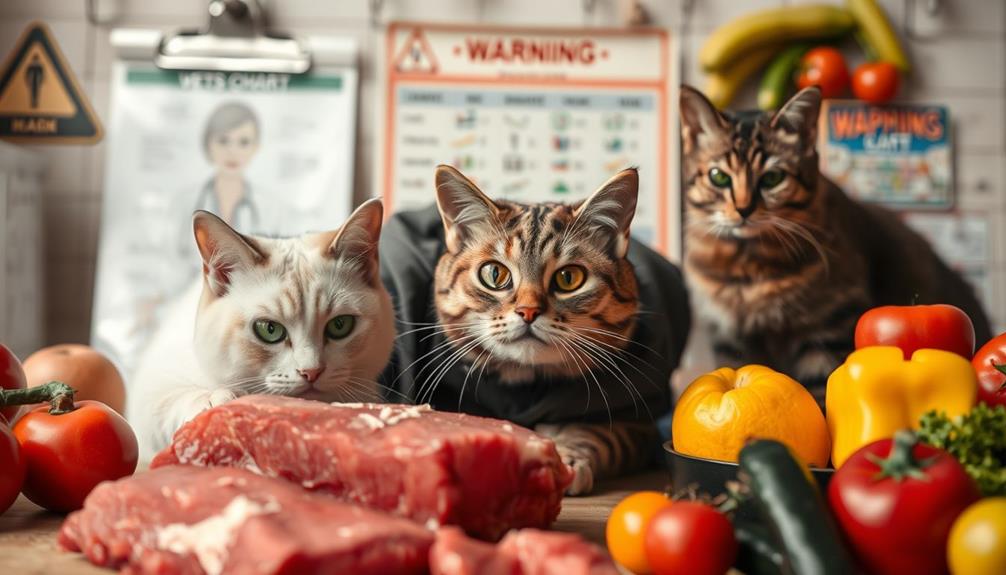
Feeding your cat a raw food diet can be risky due to harmful bacteria like Salmonella and E. coli, which can cause severe gastrointestinal issues such as vomiting and diarrhea. About 25% of raw pet food samples have tested positive for these pathogens. Additionally, raw diets often lack essential nutrients like taurine, which can lead to serious health problems over time. Contamination during preparation increases health risks not just for your cat but for humans as well. Safety practices are vital if you decide to go this route, but there are safer, balanced alternatives that might better meet your cat's needs.
Key Takeaways
- Raw food diets can expose cats to harmful pathogens like Salmonella and E. coli, posing health risks to both pets and humans.
- Nutritional deficiencies are common in raw diets, lacking essential nutrients necessary for a cat's overall health and development.
- Improper preparation and handling of raw food increase the risk of contamination, leading to severe gastrointestinal issues in cats.
- Cats can be asymptomatic carriers of pathogens, increasing the risk of transmitting infections to humans through raw food.
- High-quality commercial cat foods offer balanced nutrition and are safer alternatives, minimizing health risks associated with raw diets.
Health Risks of Raw Food
When considering a raw food diet for your cat, it's vital to understand the health risks involved. Raw food diets can carry significant contamination risks with harmful pathogens such as Salmonella and E. coli. Studies indicate that nearly 25% of raw pet food samples test positive for these bacteria. The CDC estimates that there are about 1.2 million annual cases of foodborne salmonellosis in the U.S., and your cat could act as an asymptomatic carrier, increasing the risk of human exposure.
Additionally, just as in financial planning for elderly care, understanding the long-term impact of dietary choices is important for maintaining overall health and well-being.
Moreover, Listeria monocytogenes, another pathogen found in raw diets, poses serious dangers, especially for vulnerable populations like pregnant women and newborns. Cats fed raw diets may experience gastrointestinal issues such as vomiting and diarrhea, which can lead to severe health consequences for both them and their human caregivers.
Veterinary organizations like the CDC and AVMA strongly advise against raw diets due to these health risks. They emphasize the importance of safe handling practices to minimize contamination, but even with precautions, the dangers of raw pet food remain significant.
Ultimately, you must weigh these risks carefully when considering your cat's diet.
Nutritional Concerns
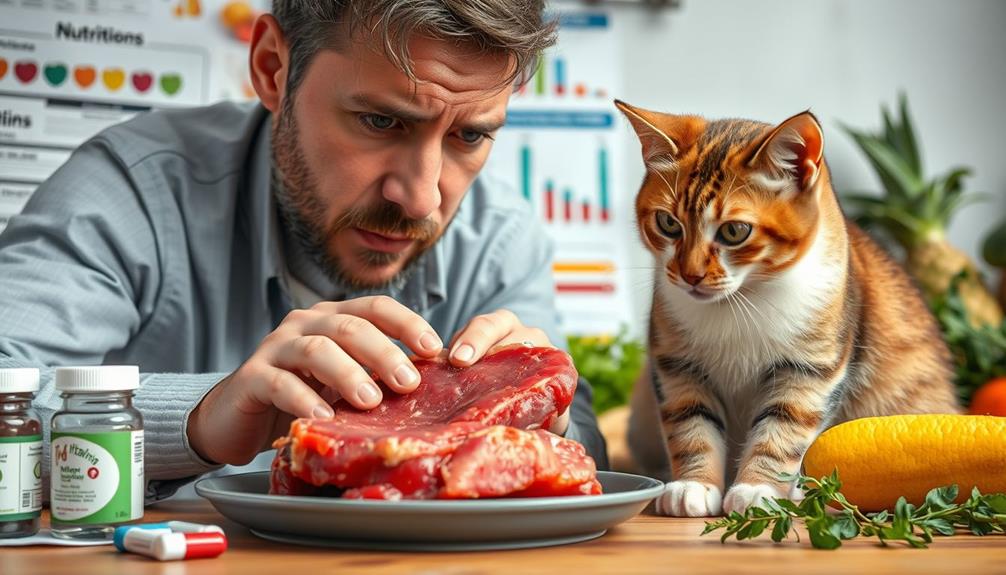
Cats thrive on balanced nutrition, but raw food diets often fall short in providing essential nutrients. Many raw food diets lack essential components like taurine, vitamins A, D, and E, which are critical for your cat's health. Without these essential nutrients, your feline friend could face serious nutritional deficiencies that lead to health issues over time.
Furthermore, it's important to understand the implications of dietary choices on overall health and wellness, as proper budgeting for pet care guarantees your cat receives the best nutrition possible.
Homemade raw diets frequently miss the mark on meeting complete and balanced nutritional requirements. This oversight can result in calcium imbalances, affecting bone health and overall development, particularly in growing cats. In adult cats, these imbalances can also lead to significant health concerns.
Additionally, without veterinary guidance, feeding your cat a raw food diet can be risky. Only a small percentage of analyzed homemade raw diets have been found to be complete and balanced. The potential for harmful bacteria in raw diets can further complicate nutritional adequacy, as it may contribute to nutrient loss.
To guarantee your cat receives the balanced diet they need, consult with a veterinarian before making any changes to their diet, especially if you're considering raw food options.
Pathogen Contamination
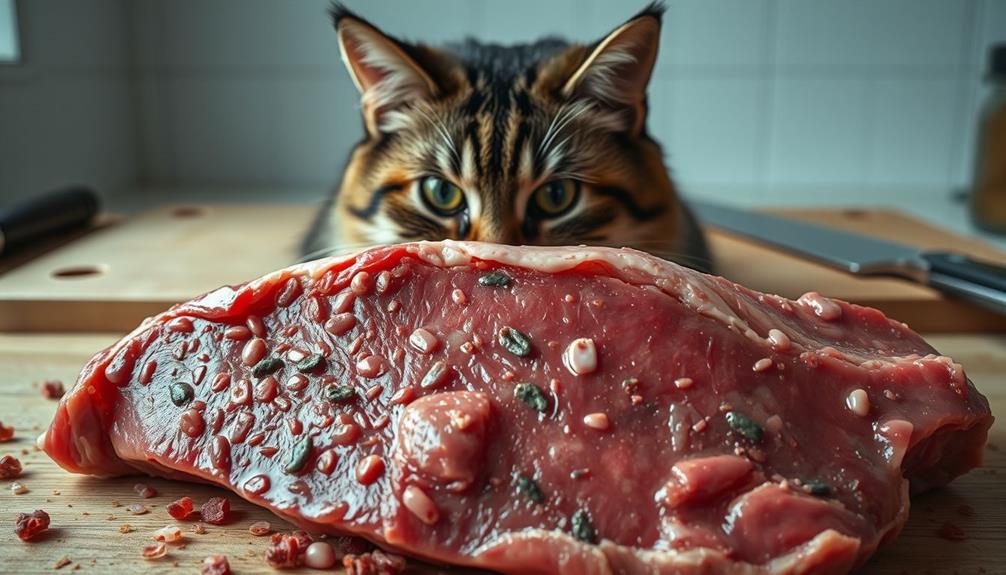
Feeding your cat a raw food diet can open the door to serious health risks, particularly due to pathogen contamination. Studies show that nearly 25% of raw cat food samples are contaminated with harmful bacteria, including Salmonella and Listeria.
These pathogens can pose significant risks not only to your cat but also to your household. Pets with emotional dysregulation, such as those with BPD dynamics in relationships, may also exhibit increased anxiety, making them more vulnerable to health issues.
Salmonella, for instance, causes around 1.2 million human infections each year, with cats often acting as asymptomatic carriers, increasing the chance of transmission to humans.
Listeria monocytogenes, another common threat in raw diets, leads to severe foodborne illnesses, contributing to approximately 1,600 cases and 260 deaths annually in the US. The risks escalate, especially in households with young children or immunocompromised individuals, as they're more vulnerable to these pathogens.
Improper preparation and handling raw food can exacerbate the risks of contamination, making it critical to understand the serious implications of a raw diet.
While your cat may enjoy the taste, the potential health hazards from contaminated raw cat food can lead to dire consequences for both your pet and your family.
Safe Handling Practices

Practicing safe handling techniques is vital to minimize the risks associated with feeding your cat a raw food diet. As a pet parent, you need to be vigilant about harmful bacteria like Salmonella and Listeria that can thrive in raw cat food.
Regularly monitoring your cat's health for any signs of illness can also be beneficial, as certain dietary choices may impact their well-being, including ultimate hamster care. Always wash your hands thoroughly with soap and water after handling any raw food. This simple step helps prevent the spread of these pathogens.
To guarantee a safe environment, clean and disinfect all surfaces, utensils, and feeding dishes that come into contact with raw food. Remember to store raw cat food in the freezer until you're ready to use it, and thaw it safely in the refrigerator or microwave. This prevents bacterial growth and keeps your cat's nutritional needs in check.
Keep raw cat food separate from human food items during storage and preparation to avoid cross-contamination. It's also important to avoid rinsing raw meat before preparation, as this can cause splashing and spread bacteria to surrounding surfaces and utensils.
Alternatives to Raw Diets
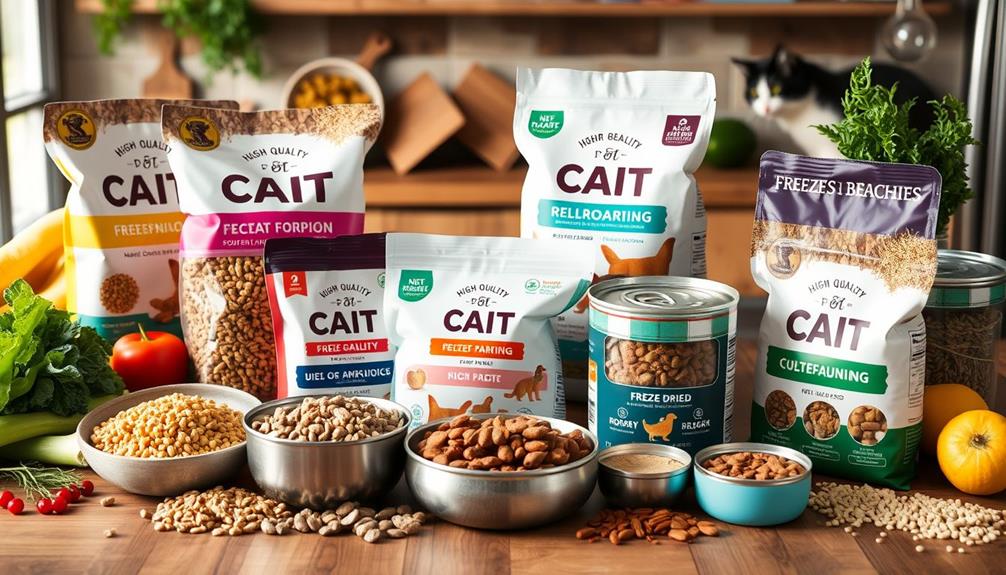
When considering alternatives to raw diets, many pet owners find themselves weighing the benefits of high-quality commercial foods. These commercially prepared options, formulated by veterinary nutritionists, provide a complete and balanced diet that meets your cat's nutritional needs without the risks associated with raw feeding.
Additionally, some commercial diets are specifically designed to support urinary health, which is essential for preventing common feline health issues recommendations for usage based on symptoms.
Cooked food is another excellent choice. It can be tailored to eliminate harmful bacteria, making it a safer alternative to raw diets. High-quality canned cat foods often have higher moisture content, supporting hydration and benefiting your cat's urinary health.
If your cat has food sensitivities or allergies, you might explore limited ingredient diets (LID) or hypoallergenic commercial foods. These options provide safe alternatives without the dangers linked to raw diets.
It's vital to consult with a veterinarian when making dietary changes. They can guide you in selecting high-quality commercial diets or cooked homemade meals that align with your cat's health needs.
Frequently Asked Questions
Why Is Raw Food Bad for Cats?
Raw food diets can expose your cat to harmful bacteria and nutritional deficiencies. They often lack essential nutrients, and unprocessed bones might cause serious injuries. It's best to stick to balanced, vet-recommended diets for your cat's health.
Why Do Vets Say Raw Food Is Bad?
Oh sure, let's serve your cat raw meat like a gourmet delicacy! Vets warn against it because of bacteria, nutrient deficiencies, and potential harm to both your pet and your family. Cooked food's safer, trust them!
Do Vets Recommend a Raw Diet for Cats?
Most vets don't recommend a raw diet for cats due to health risks like bacterial contamination and nutritional imbalances. They suggest opting for high-quality commercial cat foods to guarantee your pet's health and well-being.
What Are the Dangers of Raw Food?
Raw food diets can expose your cat to harmful bacteria like Salmonella and E. coli, leading to severe illness. They might also cause nutrient deficiencies and pose choking hazards from unprocessed bones, risking your cat's health. Additionally, raw food diets can lead to potential dental issues and digestive problems for cats. In fact, some studies have linked raw food diets to an increased risk of tooth decay and gum disease in cats. Furthermore, it’s important to note that raw food and dog constipation can also be a concern, as the lack of fiber in raw diets can lead to bowel irregularities and discomfort for pets. Therefore, it’s crucial to carefully consider the potential risks before deciding to switch your cat to a raw food diet.
Conclusion
In the grand tapestry of feline nutrition, raw food might seem like a tempting thread, but it can unravel quickly with health risks and nutritional concerns. While the allure of a raw diet is strong, remember the hidden dangers lurking within pathogens that can harm your cat. By exploring safer alternatives, you can guarantee your furry friend thrives. After all, a happy cat is a healthy cat, and that's the purrfect goal for every pet owner!
With her ability to convey complex concepts in a clear and accessible manner, Belinda ensures that readers of all backgrounds can grasp the benefits and techniques of raw food. She excels at breaking down scientific information into digestible pieces, allowing readers to understand the impact of raw food on their bodies and encouraging them to make informed choices about their diet.
One of Belinda’s notable contributions to rachaelsrawfood.com is her collection of mouthwatering recipes. She delights in experimenting with various combinations of raw ingredients, exploring innovative ways to create delicious and nutritious meals. Belinda’s recipes showcase the incredible flavors and textures of raw food and emphasize its versatility, dispelling any misconception that a raw food diet is limited or monotonous.
In addition to her writing responsibilities, Belinda actively engages with the raw food community, attending workshops, seminars, and conferences to expand her knowledge and network. She enjoys connecting with like-minded individuals, exchanging ideas, and staying up to date with the latest trends and advancements in the field of raw food nutrition.
Kitchen Essentials for Raw Food Preparation
Which Raw Food Should Be Stored Above? Essential Tips
Learn the crucial hierarchy of raw food storage to prevent cross-contamination and ensure safety—discover the essential tips that could change your kitchen practices!
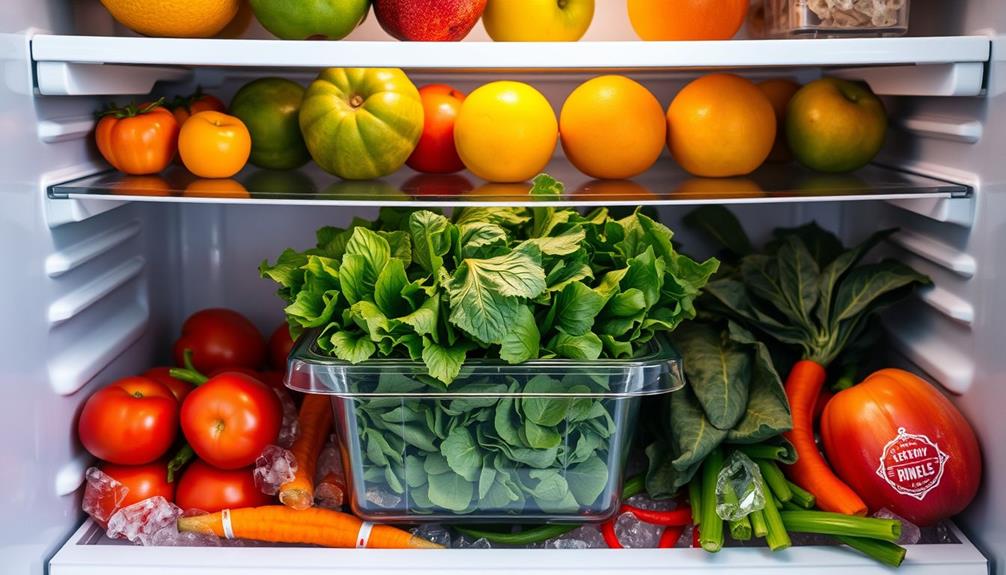
When organizing your refrigerator, always store raw fish on the top shelf. This placement minimizes the risk of cross-contamination with other foods. It's essential to wrap the fish tightly in plastic wrap or foil and keep it in a sealed container to prevent exposure to contaminants. Below the fish, you can store whole cuts of beef and pork on the middle shelf, while ground meats go lower. Finally, raw poultry should be on the bottom shelf to avoid any leakage. Understanding these storage tips can greatly enhance your food safety practices. You'll discover even more helpful advice ahead.
Key Takeaways
- Store raw fish on the top shelf to minimize the risk of cross-contamination with other foods.
- Whole cuts of beef and pork should be placed directly below fish on the middle shelf.
- Ground meats must be stored on the lower middle shelf, beneath whole cuts of beef and pork.
- Raw poultry should always be kept on the bottom shelf to prevent juices from contaminating other items.
- Use sealed containers for all raw foods to further reduce the risk of contamination.
Importance of Food Hierarchy
When it comes to food storage, understanding the importance of food hierarchy is vital for maintaining safety in your kitchen. By organizing your refrigerator correctly, you can minimize the risk of cross-contamination, which is essential for raw food safety. Proper food storage practices can help ward off foodborne illnesses, similar to how cold medications should be chosen for effective relief.
Start with seafood, which should always be stored on the top shelf. It's the most perishable and should be kept above other raw foods to prevent any juices from dripping down.
Next, place whole cuts of beef and pork on the middle shelf. This keeps them safely above ground meats and seafood, adhering to the food storage hierarchy. Ground meats and fish should be stored on the lower middle shelf, where they can be contained separately from poultry, which you must always put on the bottom shelf. This prevents any juices from raw poultry from contaminating other foods, markedly reducing cross-contamination risks.
Following this organization not only minimizes the chances of foodborne illnesses but also makes it easier to access your ingredients when cooking. By adhering to these guidelines, you guarantee that your kitchen remains safe and efficient while handling raw foods.
Storing Fish Correctly

When storing fish, it's vital to prioritize proper storage techniques to keep it fresh and safe.
You should always maintain the right temperature and take steps to prevent cross-contamination, especially with other raw foods.
Regular cleaning of storage areas is essential to guarantee hygiene and minimize the risk of foodborne illnesses.
Importance of Proper Storage
Storing fish correctly is essential for maintaining its freshness and guaranteeing food safety. To prevent contamination, always place fish on the top shelf of your refrigerator. This helps minimize the risk of juices leaking from raw meats or poultry stored below, which could spoil your fish.
Additionally, consider incorporating aquatic exercise into your routine, as it promotes overall health which is beneficial when handling and preparing food. Wrapping your fish tightly in plastic wrap or aluminum foil is important, as it prevents exposure to contaminants and helps maintain its quality.
Be certain to store fish in a sealed container, keeping it separate from raw meats and poultry. This extra layer of protection further reduces the risk of cross-contamination.
Regularly check the use-by dates on your fish to verify you're consuming it while it's still safe. Proper refrigeration is essential; keep your fish at or below 5 °C to inhibit harmful bacteria growth.
Temperature Control Guidelines
Maintaining the right temperature is essential for guaranteeing your fish stays fresh and safe to eat. Store your fish on the top shelf of the fridge to avoid cross-contamination with other raw foods like beef and pork. The ideal storage temperature for fish is below 5 °C, which helps minimize bacterial growth and keeps it fresh.
Here's a quick overview of proper fish storage:
| Storage Guidelines | Details |
|---|---|
| Ideal Temperature | Below 5 °C |
| Storage Location | Top shelf of the fridge |
| Wrap | Tightly in plastic wrap or aluminum foil |
| Below Fish | Whole cuts of beef and pork |
Always check the temperature of your fridge regularly to guarantee it stays at or below that critical level. Wrapping your fish tightly prevents exposure to contaminants, further maintaining its quality. Following these temperature control guidelines will help keep your fish safe and delicious for you and your family.
Cross-Contamination Prevention Strategies
To keep your fish safe from cross-contamination, always place it on the top shelf of your refrigerator. This prevents fish juices from dripping onto other raw foods, reducing the risk of spoilage and bacteria spreading.
Proper food handling and storage practices are fundamental to maintaining a safe kitchen environment, especially when it comes to preventing cross-contact with other raw ingredients.
Here are three fundamental strategies for storing fish correctly:
- Use a Sealed Container: Store your fish in a well-sealed container or tightly wrapped to minimize any leakage. This is critical in preventing cross-contamination with other foods.
- Separate Storage: Always keep fish separate from raw poultry and meats. These should be placed on the lower shelves to avoid any drips that could contaminate the fish.
- Monitor Temperature: Verify your refrigerator maintains a temperature of 5 °C or below. This is essential for temperature management and helps inhibit bacterial growth, keeping your fish fresh longer.
Regularly check your fish for signs of spoilage and consume or cook it within a safe timeframe.
Poultry Safety Practices
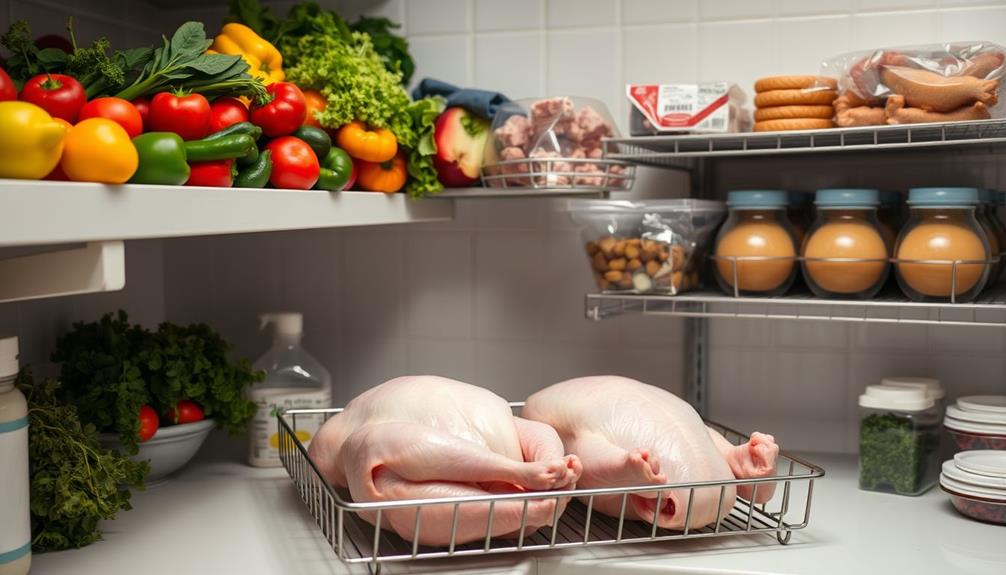
When it comes to poultry safety, proper storage is key to preventing foodborne illnesses. Always store raw poultry on the bottom shelf of your fridge to avoid cross-contamination, and make sure it's in a sealed container.
Additionally, understanding the importance of budgeting for food expenses can help you manage your grocery costs effectively.
Keeping poultry at safe cooking temperatures is just as important—let's explore how to do this effectively.
Proper Storage Hierarchy
Properly organizing your refrigerator is vital for poultry safety and overall food hygiene. Establishing a clear storage hierarchy helps prevent cross-contamination and guarantees your food stays safe.
For instance, keeping your raw meats properly stored can greatly reduce the risk of foodborne illnesses, as noted in hamster care and costs regarding proper food handling.
Here's how you can organize your raw foods effectively:
- Top Shelf: Store whole fish here. Keeping it above all other raw foods minimizes cross-contamination risks.
- Middle Shelf: Place whole cuts of beef and pork on this level, guaranteeing they're below fish but above ground meats. This organization helps maintain proper cooking temperature guidelines.
- Bottom Shelf: Raw poultry belongs here to prevent its juices from dripping onto other foods, especially ready-to-eat items located above.
Always wrap your raw foods securely in plastic wrap or aluminum foil to prevent leakage and contamination within the fridge.
By following this structured organization, you greatly reduce the chances of harmful bacteria spreading among your food.
Avoid Cross-Contamination Techniques
Cross-contamination is a serious concern in the kitchen, especially with raw poultry. To guarantee food safety, always store raw poultry on the bottom shelf of your refrigerator. This prevents its juices from dripping onto other foods, which can lead to harmful bacteria spreading. Use a sealed container or plastic bag to minimize any risk of leakage.
Early detection of foodborne illnesses can be vital, much like the importance of mammography for early detection in breast cancer.
It's essential to follow the food hierarchy; store raw poultry above raw meats and seafood. This simple step can considerably reduce the risk of cross-contamination. When preparing meals, always use separate cutting boards for raw poultry and other ingredients to avoid cross-contact of pathogens like Salmonella.
Maintaining proper refrigeration temperatures is vital, too—ideally below 5 °C. This inhibits the growth of harmful bacteria that can thrive in warmer environments. Regularly check your refrigerator to guarantee it's keeping the right temperatures.
Safe Cooking Temperatures
Cooking poultry safely is vital for preventing foodborne illnesses. To guarantee you're cooking your poultry properly, always check the internal temperature with a food thermometer. The safe cooking temperature for all poultry products, including whole birds and ground poultry, is 165°F (74°C).
It's essential to maintain a clean cooking environment and utilize proper food storage practices for peak safety, especially if you have pets that might introduce allergens into your home, as best vacuums for dust removal in 2024 can help eliminate any lingering particles.
Here are some key tips to follow:
- Store Raw Poultry: Always keep raw poultry on the bottom shelf of your fridge to prevent juices dripping onto other foods and causing cross-contamination.
- Thawing Methods: Thaw frozen poultry safely in the refrigerator, in cold water, or in the microwave. Avoid thawing at room temperature to minimize bacterial growth.
- Leftover Cooked Poultry: Refrigerate any leftover cooked poultry within two hours of cooking. Consume it within 3-4 days for peak food safety.
Managing Raw Meat Storage
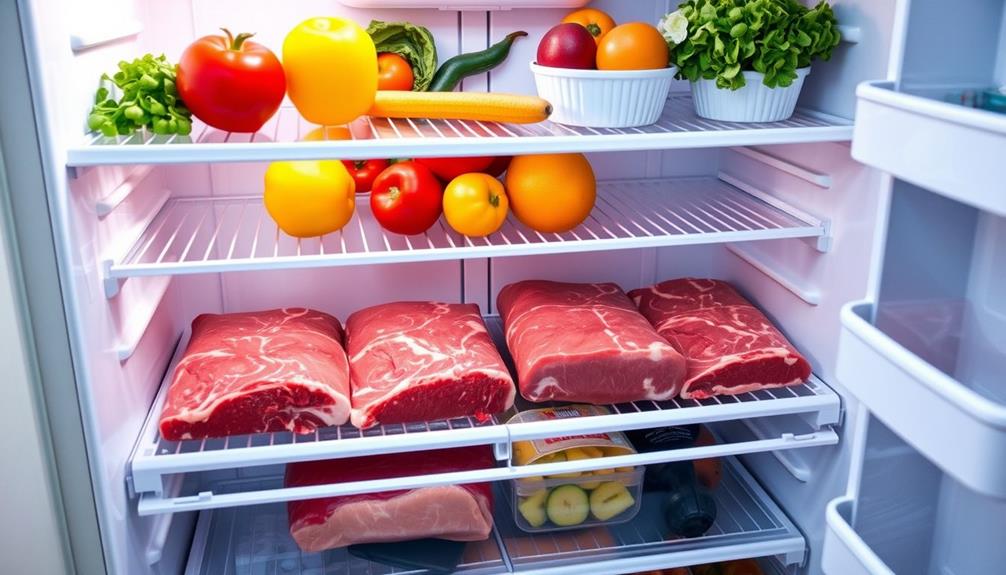
When it comes to managing raw meat storage, organization is key to ensuring food safety.
Start by storing fish on the top shelf of your refrigerator. This placement minimizes the risk of contamination with other raw foods.
It's also important to maintain a clean refrigerator environment to prevent any airborne bacteria from settling on surfaces, much like the air purifier maintenance dos and don'ts.
Below the fish, place whole cuts of beef and pork on the middle shelf. This arrangement prevents any drips that could potentially contaminate lower shelves.
Ground meats, including beef and pork, should occupy a lower shelf to reduce the risk of bacterial spread from their juices.
Preventing Cross-Contamination
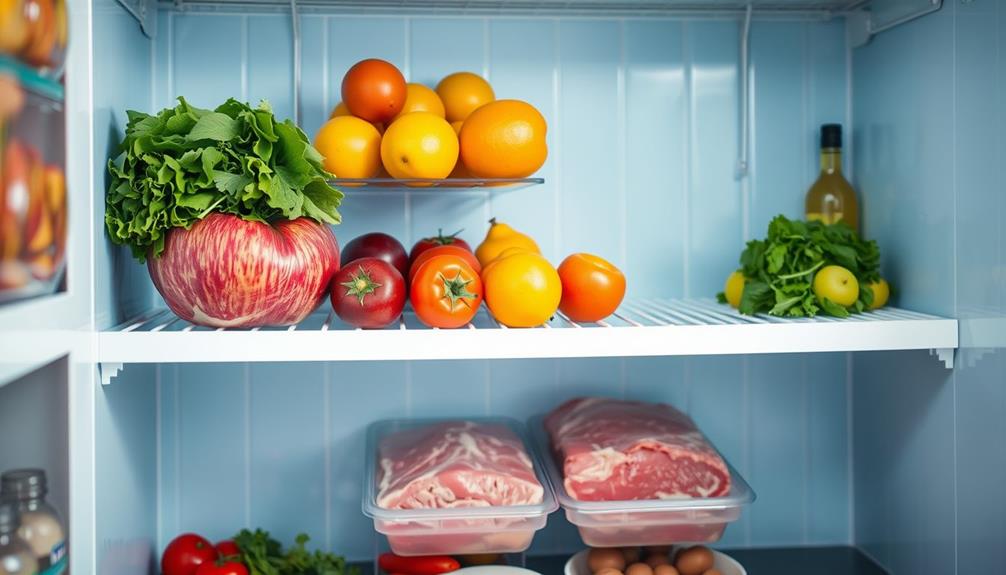
Maintaining a safe food environment means taking steps to prevent cross-contamination in your kitchen. To keep harmful bacteria at bay, you need to store raw foods correctly and guarantee that they're separate from cooked foods. Here are some essential tips to help you achieve that:
1. Store Raw Foods in Order: Always place fish at the top, followed by whole cuts of beef or pork, ground meats, and finally poultry at the bottom. This arrangement minimizes the risk of drips and leakage contaminating other items. Additionally, it’s important to store raw foods in sealed containers or leak-proof bags to further prevent cross-contamination. When storing raw foods in the refrigerator, always keep them separate from ready-to-eat items, and use different cutting boards and utensils for preparing raw meats and other foods. Following these raw food storage tips can help reduce the risk of foodborne illness and keep your kitchen safe.
Additionally, just as proper maintenance is vital for heat pumps to function effectively, maintaining proper food storage practices is fundamental for food safety.
2. Use Sealed Containers: Keep raw foods in sealed containers or plastic bags. This greatly reduces the chances of leakage, which can spread harmful bacteria and lead to foodborne illnesses.
Using sealed containers is similar to how energy-saving features in heat pumps help minimize inefficiencies and enhance performance.
3. Organize Food Storage: Regularly check and organize your food storage. Confirm that cooked foods are always stored above raw items to maintain that vital separation.
Food Safety Guidelines
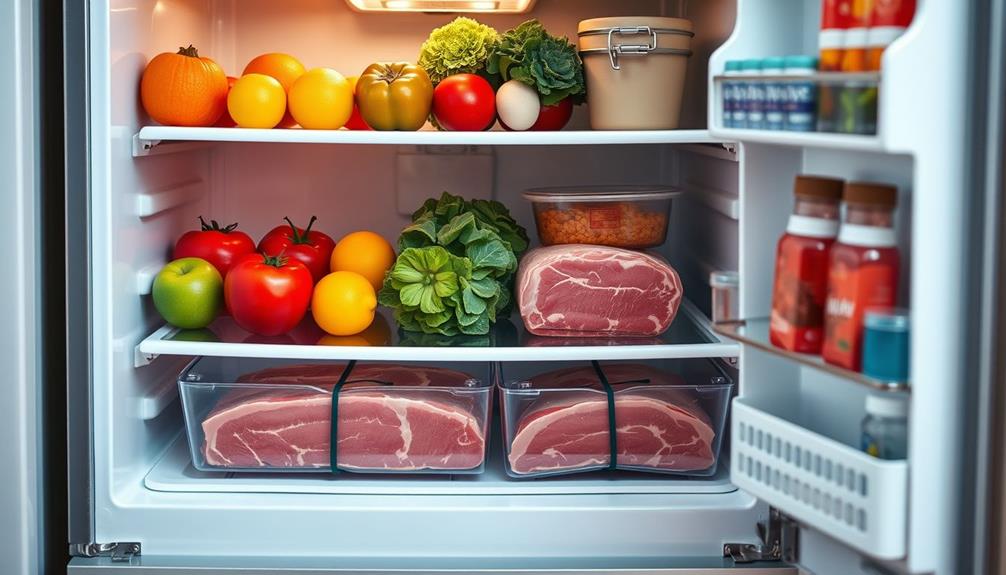
Food safety guidelines are essential for guaranteeing that your raw ingredients remain safe to eat and won't lead to foodborne illnesses. To maintain a safe storage hierarchy, place raw fish at the top of your refrigerator. This minimizes the risk of cross-contamination from its juices.
Additionally, understanding the importance of proper food handling can greatly reduce health risks associated with foodborne pathogens, similar to the ways caregivers manage financial considerations for elderly care to guarantee safety and well-being.
Below the fish, store whole cuts of beef and pork, which are less likely to harbor harmful bacteria compared to ground meats. Ground meats, like ground beef and pork, should be stored beneath whole cuts to prevent bacterial spread.
Finally, keep raw poultry—such as whole and ground chicken—on the bottom shelf, as it poses the highest risk of carrying pathogens like salmonella.
Always wrap your raw foods securely in aluminum foil or plastic wrap. This prevents exposure to contaminants and avoids any leakage that could affect other foods in your fridge.
Best Storage Containers
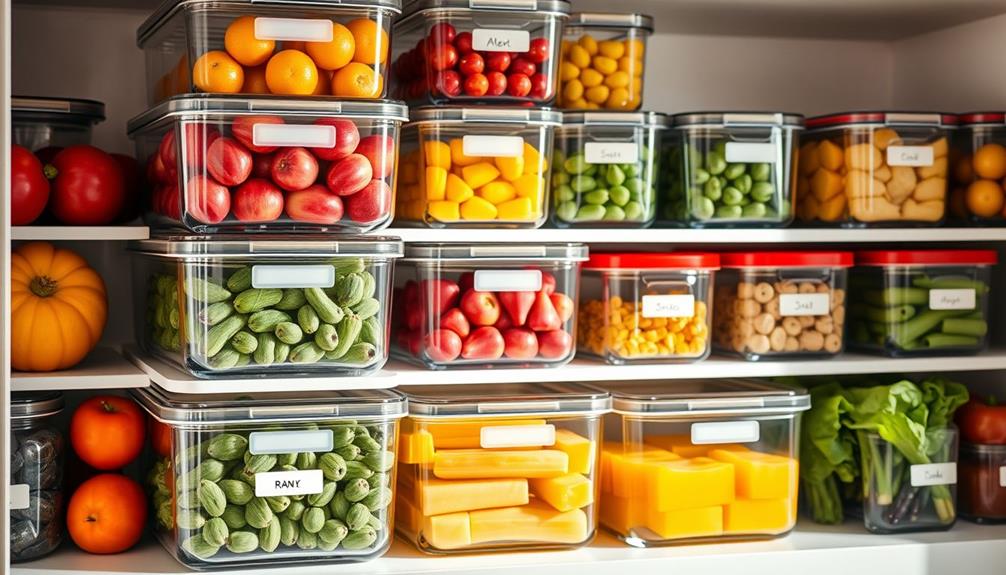
Choosing the right storage containers can make a big difference in keeping your raw foods safe and fresh. To effectively prevent cross-contamination and maintain the quality of your ingredients, consider these tips:
- Use airtight containers: Opt for glass or BPA-free plastic containers with tight-fitting lids. They not only prevent leaks but also keep odors from mingling and help maintain freshness.
- Label everything: Clearly label your storage containers with the contents and date of storage. This practice guarantees you track use-by dates and minimizes the risk of using spoiled food.
- Create visual distinction: Utilize separate colored containers for different food groups like raw meat, poultry, and seafood. This method aids in easily identifying contents and greatly reduces cross-contamination risks.
For freezer use, choose thicker food storage bags designed for that purpose. They're less likely to puncture or leak, guaranteeing your raw foods stay safe.
Frequently Asked Questions
Which Raw Food Should Be Stored Above?
When storing raw foods, you should place whole fish on the top shelf. This helps reduce cross-contamination risks. Remember to wrap them securely to prevent any leaks that could affect other items below.
Which Food Should Be Stored Above?
Imagine the chaos of a kitchen gone wrong. You should store fish on the top shelf to prevent cross-contamination. It's essential for maintaining safety, ensuring your meals are delicious and free from any harmful bacteria.
Which Food Should Be Stored Above Others in the Refrigerator?
When storing food in your refrigerator, always place fish on the top shelf. It minimizes cross-contamination risks. Below that, keep whole cuts of beef and pork, followed by ground meats and poultry on the bottom.
What Is the Proper Way of Storing Raw Food?
Imagine your fridge as a well-organized library. When storing raw food, wrap it tightly, use sealed containers, and arrange by type. This keeps everything fresh and prevents contamination, just like protecting valuable books from damage.
Conclusion
By understanding the importance of food hierarchy and proper storage techniques, you can keep your kitchen safe and your meals delicious. Just like stacking building blocks, each layer of food needs to be placed thoughtfully to prevent disaster. Remember to store fish above poultry, and always keep raw meat at the bottom. With these tips, you'll guarantee freshness while protecting your loved ones from cross-contamination. Your kitchen can be a safe haven for healthy eating!
Rachael, the Editor in Chief of RachaelsRawFood.com, is an inspiring and passionate individual who has dedicated her life to promoting the benefits of a raw food lifestyle. Known for her vibrant and energetic personality, Rachael has built a strong online presence that has transformed her personal journey into a thriving community of raw food enthusiasts.
-
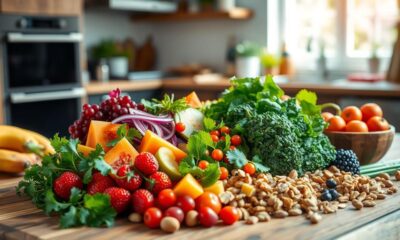
 Health and Wellness2 months ago
Health and Wellness2 months agoDoes Eating Raw Food Help You Lose Weight? Discover the Truth
-

 Raw Food Recipes2 months ago
Raw Food Recipes2 months agoHow Much Raw Food to Feed Your Puppy: Essential Tips
-

 Kitchen Essentials for Raw Food Preparation1 month ago
Kitchen Essentials for Raw Food Preparation1 month agoCan You Cook Raw Food in an Air Fryer? Discover the Possibilities
-

 Raw Food Recipes2 months ago
Raw Food Recipes2 months agoHow to Defrost Dog Raw Food Properly
-

 Health and Wellness2 months ago
Health and Wellness2 months agoHow Long Does It Take Bacteria to Spread From Raw Food? Essential Info
-
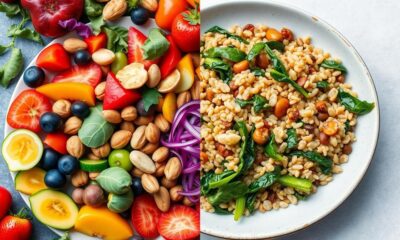
 Raw Food Recipes2 months ago
Raw Food Recipes2 months agoRaw Food Vs. Vegan: Which Diet Is Better?
-

 Raw Food Recipes2 months ago
Raw Food Recipes2 months agoIs Raw Food Good for Cats? Find Out Here
-
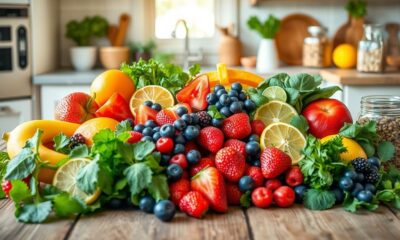
 Raw Food Recipes2 months ago
Raw Food Recipes2 months agoWhat Is the Raw Food Diet? A Comprehensive Overview


